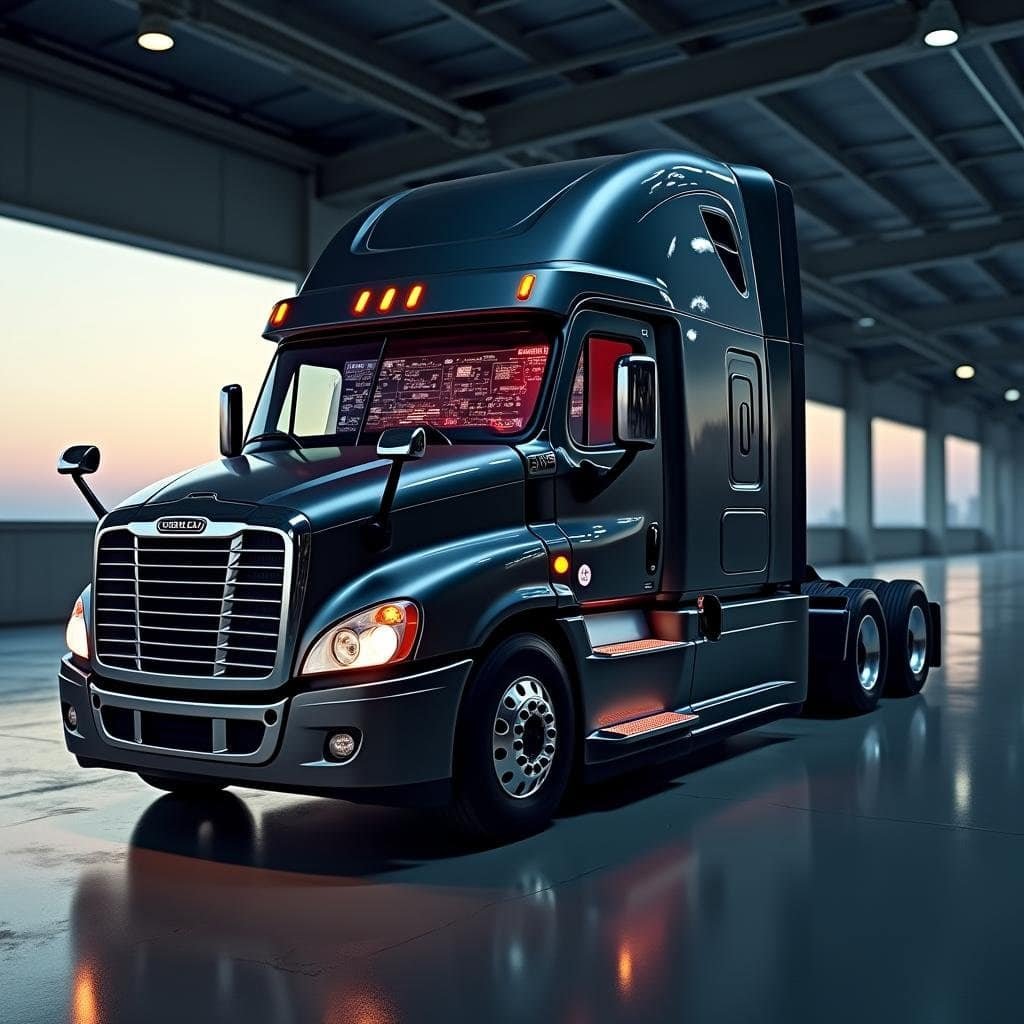The trucking industry has always been at the forefront of adopting new technologies to enhance safety, efficiency, and driver experience. In recent years, one innovation has captured the imagination of fleet managers and technology enthusiasts alike: holographic displays for commercial trucks. This cutting-edge technology represents a significant leap forward in how drivers interact with their vehicles and perceive information on the road. By implementing hologram truck safety systems, companies can revolutionize their operations while potentially saving lives. This comprehensive guide will walk you through everything you need to know about implementing holographic truck displays, from the basic technology to practical implementation steps.
Understanding Holographic Technology for Trucks
Holographic displays utilize advanced optical technology to project three-dimensional images that appear to float in space. Unlike traditional displays that are confined to flat screens, holograms can present information in the driver’s field of view without obstructing their vision of the road. This creates an augmented reality experience that blends digital information with the real world.
The core technology behind truck holograms involves:
- Light projection systems that create the visual elements
- Spatial mapping technology that positions information correctly in 3D space
- Motion and environment sensors that adapt the display to driving conditions
- Processing units that render complex data into useful visual formats
According to research from the National Highway Traffic Safety Administration, visual distractions are a leading cause of commercial vehicle accidents. Holographic displays address this by keeping the driver’s eyes on the road while simultaneously providing critical information.
The Evolution from HUDs to Holograms
Holographic displays represent the natural evolution of Heads-Up Display (HUD) technology that has been used in aviation for decades and has gradually made its way into automotive applications. While traditional HUDs project simple information like speed and navigation directions onto the windshield, holographic systems create truly three-dimensional images that can be positioned anywhere in the driver’s field of view.
The key advantages of holographic displays over traditional HUDs include:
- Greater depth perception for better spatial awareness
- Ability to highlight actual objects in the environment
- More intuitive representation of complex information
- Reduced eye strain through proper focal distances
Benefits of Holographic Displays for Truck Safety
Implementing hologram truck safety systems offers numerous advantages for fleet operations. Safety benefits stand out as the primary advantage, but the technology delivers multiple improvements across various aspects of trucking operations.
Enhanced Situational Awareness
Holographic displays can project crucial information directly into the driver’s field of view, highlighting potential hazards on the road. For example, the system might outline pedestrians crossing at night, highlight vehicles in blind spots, or enhance lane markings during poor visibility conditions.
A study published in the Society of Automotive Engineers Journal found that drivers using augmented reality displays identified road hazards up to 1.2 seconds faster than those using traditional dashboard displays – a critical time difference at highway speeds.
Reduced Cognitive Load
Long-haul truck drivers face significant cognitive challenges during extended periods behind the wheel. Holographic displays can present information in more intuitive ways, reducing the mental effort required to process critical data. For instance, instead of reading numerical distance measurements, drivers might see holographic markers showing safe following distances that adjust in real-time based on speed and road conditions.
Improved Navigation and Route Guidance
Rather than requiring drivers to glance at a separate GPS device, holographic displays can project navigation information directly onto the road ahead. Arrows can appear to be painted on the actual roadway, highlighting exactly which lane to use and when to make turns. This technology is particularly valuable in complex highway interchanges or unfamiliar urban environments.
Integrating holographic navigation with real-time traffic and weather data allows for dynamic routing suggestions that can help avoid congestion, hazardous conditions, or road closures – ultimately improving delivery times and reducing fuel consumption.
Technical Requirements for Holographic Truck Displays
Implementing holographic display technology in commercial trucks requires careful consideration of hardware, software, and integration requirements. Understanding these technical aspects is crucial for successful deployment.
Hardware Components
A complete holographic display system for commercial trucks typically includes:
- Projection Units: High-brightness, high-resolution projectors capable of creating visible images even in bright daylight conditions
- Optical Elements: Specialized lenses, mirrors, or combiners that direct light and create the illusion of depth
- Sensors Array: Multiple sensors including cameras, radar, LIDAR, and ultrasonic sensors to detect objects and conditions around the vehicle
- Processing Hardware: Powerful computing systems capable of real-time 3D rendering and sensor data fusion
- Vehicle Integration Components: Hardware interfaces that connect to the truck’s existing electronic systems
The quality of these components directly impacts the effectiveness of the holographic system. For instance, projection brightness must be sufficient to be visible in various lighting conditions, from bright sunlight to nighttime driving. Similarly, the processing system must be powerful enough to render complex 3D images without noticeable lag.
Software Requirements
The software behind holographic truck displays is equally important as the hardware. Key software components include:
- Rendering Engine: Creates the 3D visuals based on real-time data
- Sensor Fusion Algorithms: Combine data from multiple sensors to create a comprehensive view of the environment
- Machine Learning Systems: Identify objects, predict movements, and assess potential hazards
- Driver Interface: Ensures information is presented in an intuitive, non-distracting manner
- System Diagnostics: Continuously monitors system health and alerts to any malfunctions
According to transportation technology experts at the U.S. Department of Transportation’s Intelligent Transportation Systems Joint Program Office, the integration of these software components must prioritize reliability and user experience to ensure driver acceptance and safety benefits.
Implementation Steps for Holographic Truck Displays
Successfully deploying hologram truck safety systems requires careful planning and execution. Here’s a step-by-step approach to implementing this technology in your fleet:
Assessment and Planning
Begin with a thorough assessment of your current fleet operations and needs:
- Needs Analysis: Identify specific safety challenges or operational inefficiencies that holographic displays could address
- Vehicle Compatibility Assessment: Determine which trucks in your fleet can accommodate the necessary hardware
- ROI Calculation: Develop a detailed cost-benefit analysis including potential insurance savings, accident reduction, and efficiency improvements
- Implementation Timeline: Create a phased rollout plan that minimizes disruption to operations
During this phase, it’s essential to involve stakeholders from across your organization, including safety managers, drivers, maintenance personnel, and IT staff. Their input can help identify potential challenges and opportunities you might otherwise overlook.
Vendor Selection and System Design
Once you’ve established your requirements, the next step is selecting the right technology partner:
- Vendor Research: Identify providers with proven experience in commercial vehicle holographic systems
- System Specification: Work with vendors to design a system that meets your specific needs
- Integration Planning: Ensure the system will work with your existing fleet management software and telematics
- Customization Requirements: Determine what aspects of the system need to be tailored to your operations
Look for vendors who offer comprehensive support, including installation, training, and ongoing maintenance. The best partners will have experience working specifically with commercial trucking applications, not just passenger vehicles.
Testing and Pilot Implementation
Before rolling out holographic displays across your entire fleet, conduct thorough testing:
- Laboratory Testing: Verify system performance in controlled environments
- Limited Field Trials: Equip a small number of trucks with the technology
- Driver Feedback Collection: Gather detailed input from drivers using the system
- Performance Metrics Tracking: Measure safety incidents, fuel efficiency, and other relevant KPIs
- System Refinement: Make necessary adjustments based on testing results
A properly executed pilot program provides valuable data and helps identify potential issues before full-scale implementation. It also gives drivers time to adjust to the new technology and provide feedback for improvements.
Full Implementation and Training
Once testing confirms the system’s effectiveness, proceed with fleet-wide implementation:
- Installation Schedule: Develop a rollout plan that minimizes downtime
- Driver Training Program: Create comprehensive training materials and sessions
- Support System Establishment: Ensure technical support is readily available during the transition
- Ongoing Monitoring: Implement systems to track performance and identify any issues
The training component is particularly critical. Even the most advanced technology won’t deliver safety benefits if drivers don’t understand how to use it effectively or become overly reliant on it.
Overcoming Implementation Challenges
While holographic truck displays offer significant benefits, implementing this technology comes with several challenges that need to be addressed proactively.
Technical Obstacles
Several technical hurdles must be overcome when implementing holographic displays:
- Environmental Variability: The system must function reliably in all weather and lighting conditions
- Power Requirements: High-performance holographic systems demand significant electrical power
- Calibration and Maintenance: Regular adjustments may be needed to ensure optimal performance
- Integration Complexity: Connecting with existing vehicle systems can present compatibility challenges
Working with experienced vendors and conducting thorough testing can help identify and address these issues before they impact your operations. Investing in robust, commercial-grade components designed specifically for trucking applications is essential.
Driver Adaptation and Acceptance
The human element is often the most challenging aspect of implementing new technology:
- Resistance to Change: Experienced drivers may be hesitant to adopt new systems
- Learning Curve: Drivers need time to become comfortable with holographic interfaces
- Over-reliance Risk: Some drivers may become too dependent on the technology
- Distraction Potential: Poorly designed interfaces could actually increase distraction
Addressing these challenges requires a comprehensive change management approach that includes driver input throughout the design and implementation process, thorough training, and ongoing support. Implementing feedback mechanisms allows drivers to report issues and suggest improvements.
Regulatory Considerations
The regulatory landscape for advanced driver assistance systems is still evolving:
- Compliance Requirements: Systems must meet current regulations for driver interfaces
- Liability Concerns: Determining responsibility in case of system failures or accidents
- Insurance Implications: How insurers will view and value these systems
- Future Regulatory Changes: Preparing for evolving legal requirements
Working with legal experts familiar with transportation technology regulations can help navigate these complexities. It’s also important to stay informed about regulatory developments through industry associations and government communications.
Future Directions in Holographic Truck Technology
As holographic technology continues to evolve, several exciting developments are on the horizon for the trucking industry:
Integration with Autonomous Systems
Holographic displays will play a crucial role in the transition to semi-autonomous and fully autonomous trucking. In these advanced vehicles, holograms can:
- Show drivers what the autonomous system “sees” and how it’s interpreting the environment
- Highlight when manual intervention may be required
- Create a more transparent relationship between human and machine
- Facilitate safer handoffs between autonomous and manual driving modes
This transparency will be vital for building driver trust in autonomous systems and ensuring safe operation during the transition period when human oversight remains necessary.
Advanced Driver-Vehicle Interfaces
Future holographic systems will likely incorporate more interactive elements:
- Gesture control allowing drivers to manipulate holographic elements without touching physical controls
- Voice-activated holographic displays that respond to natural language commands
- Personalized interfaces that adapt to individual driver preferences and habits
- Emotional recognition that can detect driver fatigue or distraction and respond accordingly
These advancements will further reduce driver workload and create more intuitive interactions between drivers and their vehicles, potentially enabling safer operation over longer periods.
Conclusion
Implementing holographic displays in commercial trucks represents a significant opportunity to enhance safety, efficiency, and driver experience. By projecting critical information directly into the driver’s field of view, hologram truck safety systems can reduce accidents, improve operational efficiency, and ultimately save lives on our roadways.
While the technology presents implementation challenges, a systematic approach to assessment, vendor selection, testing, and training can help overcome these obstacles. As the technology continues to mature and integrate with other advanced systems, holographic displays will likely become standard equipment in commercial trucks, much as backup cameras and automatic braking systems have in recent years.
The future of trucking is being shaped by innovations like holographic displays that blend the physical and digital worlds to create safer, more efficient transportation systems. Companies that embrace these technologies early will not only benefit from improved safety records but will also position themselves as industry leaders in the adoption of life-saving technology.
Ready to explore how holographic truck displays could transform your fleet operations? Contact our team of transportation technology experts today to schedule a consultation and discover how this revolutionary technology can be implemented in your specific operation.
Frequently Asked Questions
How much do holographic truck displays typically cost to implement?
Implementation costs vary widely depending on the sophistication of the system and fleet size. Basic systems start around $2,000-$5,000 per vehicle, while comprehensive solutions with advanced features can range from $8,000-$15,000 per truck. However, many companies achieve ROI within 18-24 months through reduced accident costs, lower insurance premiums, and improved efficiency.
Do drivers need special training to use holographic displays?
Yes, proper training is essential for maximizing the safety benefits of holographic systems. Most vendors offer training programs that typically require 4-8 hours of initial instruction followed by supervised driving time. The learning curve varies by driver, but most become comfortable with the technology within a few weeks of regular use.
Can holographic displays work in all weather conditions?
Modern holographic systems are designed to function in most weather conditions, including rain, light snow, and fog. However, extreme conditions may reduce effectiveness. Advanced systems incorporate weather-adaptive features that adjust brightness, contrast, and information density based on environmental conditions to maintain visibility and prevent distraction.
How do holographic displays integrate with existing fleet management systems?
Most commercial holographic display systems offer API integration with popular fleet management platforms. This allows the holographic interface to display relevant data from your existing systems, including route information, delivery schedules, fuel efficiency metrics, and maintenance alerts. The integration process typically requires configuration by IT specialists but doesn’t usually demand major modifications to existing systems.
What maintenance is required for holographic truck display systems?
Maintenance requirements include regular cleaning of optical components, software updates (typically quarterly), and occasional recalibration. Most systems include self-diagnostic capabilities that alert fleet managers to potential issues before they affect performance. Vendors typically offer maintenance packages that include preventive service every 6-12 months, with an average annual maintenance cost of 10-15% of the initial system price.







